Audi Q6 e-tron vs BMW X5 – Which one offers the better deal?
Compare performance, boot capacity, efficiency and price at a glance.
Find out which car is the better choice for you – Audi Q6 e-tron or BMW X5?
Introducing the Rivals: Audi Q6 e-tron vs BMW X5
In the ever-evolving realm of SUVs, two models stand out: the Audi Q6 e-tron, a fully electric offering from the German automaker, and the BMW X5, notable for its hybrid powertrains. As we delve into a detailed comparison of these two vehicles, we’ll explore their technical specifications, performance capabilities, and innovative features that aim to captivate buyers in the premium SUV market.
Powertrain and Performance
The Audi Q6 e-tron represents a significant step forward in electric mobility. It is available with a robust range of electric powertrains, boasting outputs of 292 to 516 HP and an impressive torque range up to 855 Nm. It can accelerate from 0 to 100 km/h in as little as 4.3 seconds, showcasing its sporty prowess. With a maximum speed of up to 230 km/h, the Q6 e-tron offers both performance and efficiency with electricity consumption as low as 15.6 kWh/100 km. Its electric range peaks at an astonishing 656 km, proving to be one of the champions in long-distance EV travel.
On the other hand, the BMW X5 offers a variety of powertrain options including diesel, petrol, and plug-in hybrid variants. Its power outputs range from 298 HP to a staggering 625 HP in the higher-performance trims. The X5 also has great acceleration figures, with some models reaching 100 km/h in just 3.9 seconds. However, with fuel consumptions as high as 12.9 L/100 km (for the hybrid models), it may not be as cost-effective for long journeys. Furthermore, the X5 has a slightly lower maximum speed of up to 250 km/h.
Battery and Fuel Efficiency
The Q6 e-tron shines in terms of its electric battery capacity, offering options up to 94.9 kWh. In contrast, the BMW X5’s maximum battery capacity for its plug-in hybrid version is only 25.7 kWh, allowing for a somewhat limited electric-only range of 97 km. While the Q6 e-tron features CO2 emissions rated at Class A (0 g/km), the X5 falls under Class G with emissions reaching up to 291 g/km in some versions, which certainly puts the Q6 e-tron ahead in eco-friendliness.
Dimensions and Interior Space
Size and comfort are vital aspects of any SUV, and here the BMW X5 has an upper hand in terms of width and trunk capacity. The X5 measures between 4935mm and 4948mm in length and 2004mm to 2015mm in width, providing a trunk capacity of up to 650 liters. The Q6 e-tron, although slightly shorter at 4771mm and narrower at 1939mm to 1965mm, still offers a respectable trunk space ranging from 499 to 526 liters.
Both SUVs accommodate five passengers comfortably, but the interior design philosophies are distinctly different. Audi is celebrated for its luxurious, minimalist cockpit dominated by technology, offering features like the MMI infotainment system and an impressive virtual cockpit. Meanwhile, the BMW X5 boasts a sporty design with a driver-focused cockpit and advanced iDrive system, ensuring a premium experience for both driver and passengers.
Innovative Features and Technology
Technologically, the Q6 e-tron includes cutting-edge features like the latest in driver assistance systems, adaptive cruise control, lane-keeping assist, and more. Its battery management system and fast charging capabilities allow for quick and easy recharging, reflective of Audi's commitment to electric mobility innovation.
Conversely, the BMW X5 also excels in technological offerings, with a suite of driver assistance features including adaptive cruise control, lane departure warning, and a robust infotainment system that supports Apple CarPlay and Android Auto. The X5 stands out with its optional Gesture Control, allowing drivers to control certain infotainment functions with hand movements.
Conclusion: Which SUV Reigns Supreme?
In the face-off between the Audi Q6 e-tron and the BMW X5, both models cater to different audiences. The Q6 e-tron is ideal for drivers seeking an electric vehicle that excels in efficiency and advanced technology, while the BMW X5 appeals to those desiring a traditional luxury SUV with versatile powertrain options. Ultimately, the choice between these two leading SUVs will depend on the buyer's priorities—whether they lean towards the electric future embodied by Audi or the established luxury and performance pedigree of BMW.
Here’s where it gets real: The technical differences in detail
Costs and Efficiency: When it comes to price and running costs, the biggest differences usually appear. This is often where you see which car fits your budget better in the long run.
Audi Q6 e-tron has a clearly advantage in terms of price – it starts at 54400 £, while the BMW X5 costs 77100 £. That’s a price difference of around 22629 £.
As for range, the Audi Q6 e-tron performs clearly better – achieving up to 656 km, about 551 km more than the BMW X5.
Engine and Performance: Power, torque and acceleration say a lot about how a car feels on the road. This is where you see which model delivers more driving dynamics.
When it comes to engine power, the BMW X5 has a to a small extent edge – offering 625 HP compared to 516 HP. That’s roughly 109 HP more horsepower.
In acceleration from 0 to 100 km/h, the BMW X5 is a bit quicker – completing the sprint in 3.90 s, while the Audi Q6 e-tron takes 4.30 s. That’s about 0.40 s faster.
In terms of top speed, the BMW X5 performs hardly perceptible better – reaching 250 km/h, while the Audi Q6 e-tron tops out at 230 km/h. The difference is around 20 km/h.
There’s also a difference in torque: the Audi Q6 e-tron pulls somewhat stronger with 855 Nm compared to 750 Nm. That’s about 105 Nm difference.
Space and Everyday Use: Beyond pure performance, interior space and usability matter most in daily life. This is where you see which car is more practical and versatile.
Both vehicles offer seating for 5 people.
In curb weight, the Audi Q6 e-tron is slight lighter – 2200 kg compared to 2240 kg. The difference is around 40 kg.
In terms of boot space, the BMW X5 offers slightly more room – 650 L compared to 526 L. That’s a difference of about 124 L.
In maximum load capacity, the BMW X5 performs to a small extent better – up to 1870 L, which is about 341 L more than the Audi Q6 e-tron.
When it comes to payload, BMW X5 noticeable takes the win – 705 kg compared to 540 kg. That’s a difference of about 165 kg.
All in all, the Audi Q6 e-tron shows itself to be outperforms in nearly all aspects and secures the title of DriveDuel Champion.
It impresses with the more balanced overall package and proves to be the more versatile companion for everyday use.
Audi Q6 e-tron
The Audi Q6 e-tron represents a significant step forward in the realm of electric vehicles, offering a perfect blend of cutting-edge technology and timeless design. With its spacious interior and advanced infotainment system, it provides both comfort and connectivity for the modern driver. The Q6 e-tron embodies Audi's commitment to sustainability without compromising on performance or luxury.
details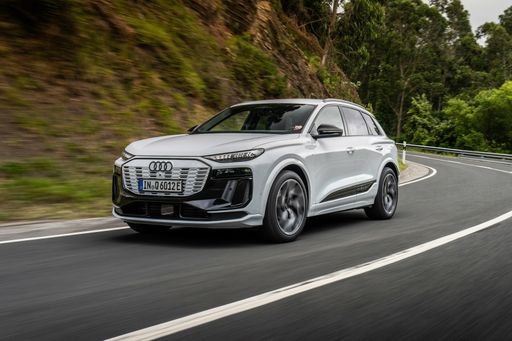 @ audi-mediacenter.com
@ audi-mediacenter.com
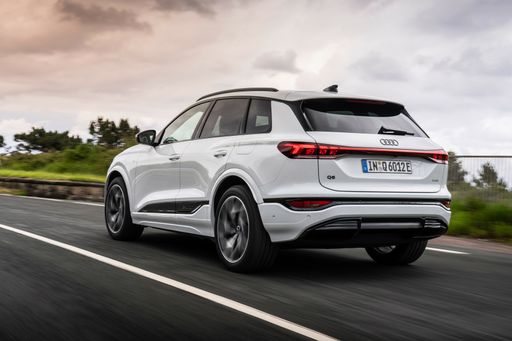 @ audi-mediacenter.com
@ audi-mediacenter.com
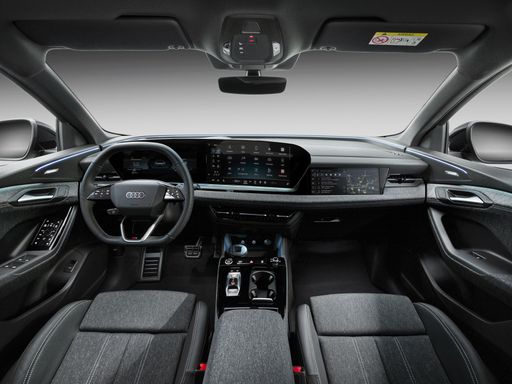 @ audi-mediacenter.com
@ audi-mediacenter.com
BMW X5
The BMW X5 embodies a perfect blend of luxury and performance, offering a driving experience that is both dynamic and comfortable. Its elegant design is complemented by a spacious, high-quality interior that prioritises driver and passenger comfort. Advanced technology features ensure that the X5 meets the demands of modern drivers, providing both entertainment and safety on the road.
details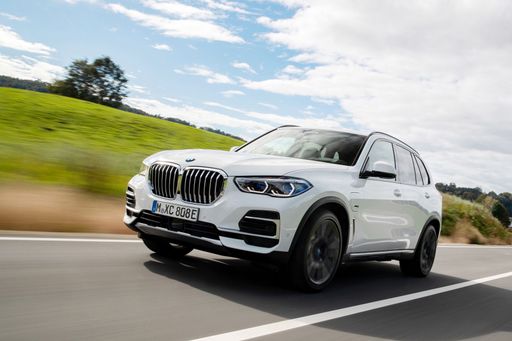 @ press.bmwgroup.com
@ press.bmwgroup.com
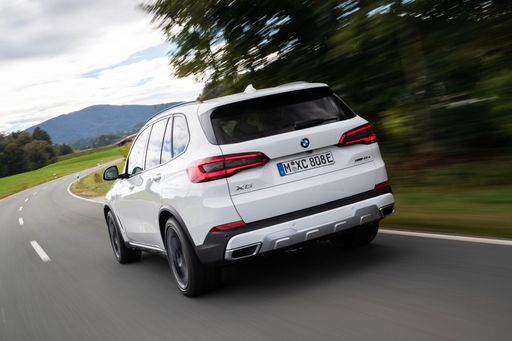 @ press.bmwgroup.com
@ press.bmwgroup.com
 @ press.bmwgroup.com
@ press.bmwgroup.com
 @ press.bmwgroup.com
@ press.bmwgroup.com
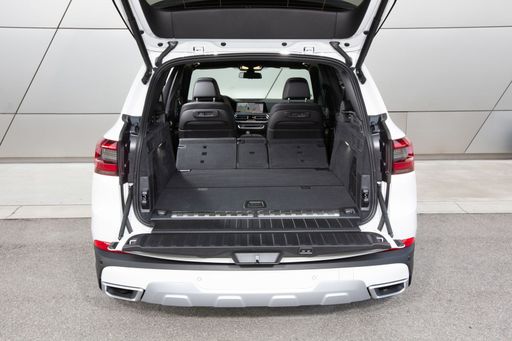 @ press.bmwgroup.com
@ press.bmwgroup.com

|

|
|
|
|
Costs and Consumption |
|
|---|---|
|
Price
54400 - 91900 £
|
Price
77100 - 143500 £
|
|
Consumption L/100km
-
|
Consumption L/100km
0.8 - 12.8 L
|
|
Consumption kWh/100km
15.6 - 18.9 kWh
|
Consumption kWh/100km
-
|
|
Electric Range
482 - 656 km
|
Electric Range
105 km
|
|
Battery Capacity
75.8 - 94.9 kWh
|
Battery Capacity
25.70 kWh
|
|
co2
0 g/km
|
co2
19 - 289 g/km
|
|
Fuel tank capacity
-
|
Fuel tank capacity
69 - 83 L
|
Dimensions and Body |
|
|---|---|
|
Body Type
SUV
|
Body Type
SUV
|
|
Seats
5
|
Seats
5
|
|
Doors
5
|
Doors
5
|
|
Curb weight
2200 - 2425 kg
|
Curb weight
2240 - 2495 kg
|
|
Trunk capacity
499 - 526 L
|
Trunk capacity
500 - 650 L
|
|
Length
4771 mm
|
Length
4935 - 4948 mm
|
|
Width
1939 - 1965 mm
|
Width
2004 - 2015 mm
|
|
Height
1665 - 1685 mm
|
Height
1755 - 1765 mm
|
|
Max trunk capacity
1361 - 1529 L
|
Max trunk capacity
1720 - 1870 L
|
|
Payload
540 kg
|
Payload
565 - 705 kg
|
Engine and Performance |
|
|---|---|
|
Engine Type
Electric
|
Engine Type
Plugin Hybrid, Petrol MHEV, Diesel MHEV
|
|
Transmission
Automatic
|
Transmission
Automatic
|
|
Transmission Detail
Reduction Gearbox
|
Transmission Detail
Automatic Gearbox
|
|
Drive Type
Rear-Wheel Drive, All-Wheel Drive
|
Drive Type
All-Wheel Drive
|
|
Power HP
252 - 516 HP
|
Power HP
298 - 625 HP
|
|
Acceleration 0-100km/h
4.3 - 7.6 s
|
Acceleration 0-100km/h
3.9 - 6.1 s
|
|
Max Speed
210 - 230 km/h
|
Max Speed
233 - 250 km/h
|
|
Torque
450 - 855 Nm
|
Torque
540 - 750 Nm
|
|
Number of Cylinders
-
|
Number of Cylinders
6 - 8
|
|
Power kW
185 - 380 kW
|
Power kW
219 - 460 kW
|
|
Engine capacity
-
|
Engine capacity
2993 - 4395 cm3
|
General |
|
|---|---|
|
Model Year
2024 - 2025
|
Model Year
2023 - 2025
|
|
CO2 Efficiency Class
A
|
CO2 Efficiency Class
B, G
|
|
Brand
Audi
|
Brand
BMW
|
What drivetrain options does the Audi Q6 e-tron have?
Available configurations include Rear-Wheel Drive or All-Wheel Drive.
The prices and data displayed are estimates based on German list prices and may vary by country. This information is not legally binding.
